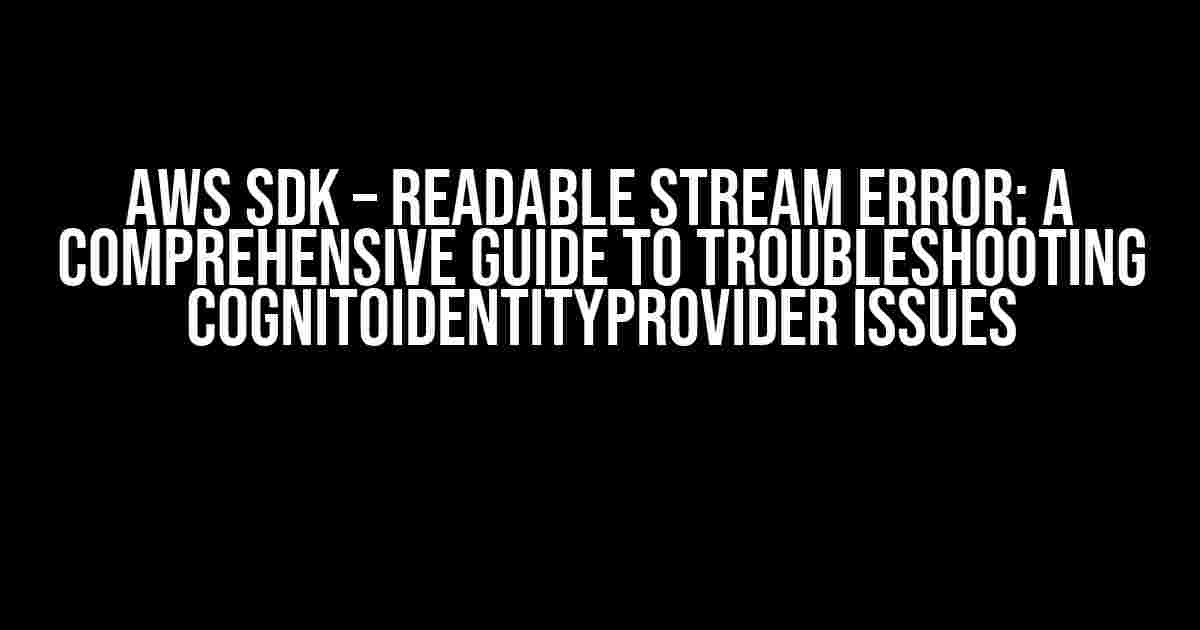Are you tired of encountering the frustrating “Readable Stream Error” when using the AWS SDK with CognitoIdentityProvider? You’re not alone! This error can be a significant roadblock in your project, but fear not, dear developer, for we’ve got your back. In this article, we’ll delve into the depths of this issue, providing you with a step-by-step guide to identify, troubleshoot, and resolve the Readable Stream Error once and for all.
What is the Readable Stream Error?
The Readable Stream Error is a common issue that occurs when the AWS SDK is unable to handle the response from the CognitoIdentityProvider. This error typically manifests as a generic “Readable Stream Error” message, without providing much insight into the underlying cause. It’s like trying to diagnose a car problem without looking under the hood – it’s a challenge!
Symptoms of the Readable Stream Error
Before we dive into the fixes, let’s identify the symptoms of this error:
- You receive a generic “Readable Stream Error” message with no additional information.
- Your AWS SDK-powered application crashes or becomes unresponsive.
- You notice slower response times or timeouts when interacting with CognitoIdentityProvider.
- Debug logs reveal errors related to stream handling or buffering.
Common Causes of the Readable Stream Error
Now that we’ve covered the symptoms, let’s explore the common causes of the Readable Stream Error:
1. Incorrect Configuration
One of the most common causes of the Readable Stream Error is an incorrect configuration of the AWS SDK or CognitoIdentityProvider. Double-check your credentials, region, and endpoint settings to ensure they match your AWS account and setup.
const AWS = require('aws-sdk');
AWS.config.update({
region: 'your-region',
accessKeyId: 'YOUR_ACCESS_KEY_ID',
secretAccessKey: 'YOUR_SECRET_ACCESS_KEY',
});
2. Incompatible SDK Version
Using an outdated or incompatible version of the AWS SDK can lead to the Readable Stream Error. Make sure you’re running the latest version of the SDK that’s compatible with your Node.js version.
npm install aws-sdk@latest
3. Insufficient Permissions
Verify that your IAM role or user has the necessary permissions to interact with CognitoIdentityProvider. Ensure you’ve granted the required permissions for your use case.
| Permission | Description |
|---|---|
| cognito-identity:ListTagsForResource | Required for listing tags for a user pool or identity pool. |
| cognito-identity:GetOpenIdToken | Required for fetching OpenID tokens for authentication. |
4. Network Connectivity Issues
Intermittent network connectivity issues or slow internet speeds can cause the Readable Stream Error. Check your network connection and try restarting your application or retrying the request.
Resolving the Readable Stream Error
Now that we’ve covered the common causes, let’s dive into the solutions:
1. Enable Debug Logging
Enable debug logging for the AWS SDK to gather more information about the error. This will help you identify the root cause of the issue.
const AWS = require('aws-sdk');
AWS.config.update({
debug: true,
});
2. Verify CognitoIdentityProvider Credentials
Double-check your CognitoIdentityProvider credentials, including the User Pool ID, App Client ID, and secret keys. Ensure they’re correct and up-to-date.
const AWS = require('aws-sdk');
const poolData = {
UserPoolId: 'YOUR_USER_POOL_ID',
ClientId: 'YOUR_CLIENT_ID',
ClientSecret: 'YOUR_CLIENT_SECRET',
};
const userPool = new AWS.CognitoIdentityServiceProvider({
region: 'your-region',
});
userPool.getUser(poolData, (err, data) => {
if (err) {
console.log(err);
} else {
console.log(data);
}
});
3. Implement Retry Mechanism
Implement a retry mechanism to handle transient errors, such as network connectivity issues. This will help your application recover from temporary failures.
const AWS = require('aws-sdk');
const retry = (fn, retries = 3, delay = 1000) => {
let attempt = 0;
return new Promise((resolve, reject) => {
const retryFn = () => {
attempt++;
fn()
.then(resolve)
.catch((err) => {
if (attempt < retries) {
console.log(`Retry ${attempt} in ${delay}ms`);
setTimeout(retryFn, delay);
} else {
reject(err);
}
});
};
retryFn();
});
};
retry(() => {
// Your CognitoIdentityProvider request goes here
}).then((data) => {
console.log(data);
}).catch((err) => {
console.error(err);
});
4. Upgrade to the Latest AWS SDK
Ensure you’re running the latest version of the AWS SDK, which often includes bug fixes and performance improvements.
npm install aws-sdk@latest
5. Check for Service Updates
Regularly check the AWS status page and CognitoIdentityProvider documentation for any service updates, maintenance, or known issues that might be causing the Readable Stream Error.
Conclusion
The Readable Stream Error can be a frustrating roadblock in your AWS-powered project. By following the steps outlined in this guide, you’ve taken a significant step towards resolving this issue and ensuring a smooth experience for your users. Remember to:
- Verify your AWS SDK configuration and credentials.
- Ensure you’re running the latest version of the AWS SDK.
- Implement a retry mechanism to handle transient errors.
- Check for service updates and maintenance.
Don’t let the Readable Stream Error hold you back! Debug, troubleshoot, and resolve with confidence using the guidance provided in this article. Happy coding!
Here are 5 questions and answers about “AWS SDK – Readable Stream Error while using CognitoIdentityProvider or any aws-sdk”:
Frequently Asked Question
Get the inside scoop on AWS SDK and troubleshoot like a pro!
Why do I get a Readable Stream Error when using CognitoIdentityProvider with AWS SDK?
This error often occurs when the AWS SDK is not properly configured to handle readable streams. Make sure you’re using the correct version of the SDK and that you’ve imported the `stream` module correctly. Also, ensure that your AWS credentials are set up correctly, and that you’re not accidentally creating multiple instances of the CognitoIdentityProvider client.
How do I troubleshoot a Readable Stream Error in AWS SDK?
Start by checking the error message for any clues about what’s going wrong. Then, review your code to ensure you’re properly handling readable streams and that you’re not prematurely closing the stream. If that doesn’t work, try enabling debug logging to get more information about the error. Finally, try updating your AWS SDK to the latest version to ensure you have the latest bug fixes.
Can I use a readable stream with CognitoIdentityProvider to authenticate users?
Yes, you can use a readable stream with CognitoIdentityProvider to authenticate users. In fact, the CognitoIdentityProvider client in the AWS SDK uses readable streams under the hood to communicate with the Cognito Identity service. Just make sure you’re properly handling the stream and its events to ensure a successful authentication flow.
What are some common causes of Readable Stream Errors in AWS SDK?
Some common causes of Readable Stream Errors in AWS SDK include: incorrect AWS credentials, network connectivity issues, invalid or malformed requests, and incorrect SDK configuration. Additionally, using an outdated version of the AWS SDK or incompatible dependencies can also lead to readable stream errors.
How do I handle readable streams in AWS SDK to avoid errors?
To handle readable streams in AWS SDK, make sure you’re properly importing the `stream` module and creating a readable stream instance correctly. Then, use the `pipe()` method to attach event listeners to the stream and handle its events, such as `data`, `error`, and `end`. Finally, ensure you’re properly closing the stream when you’re done with it to avoid memory leaks.



